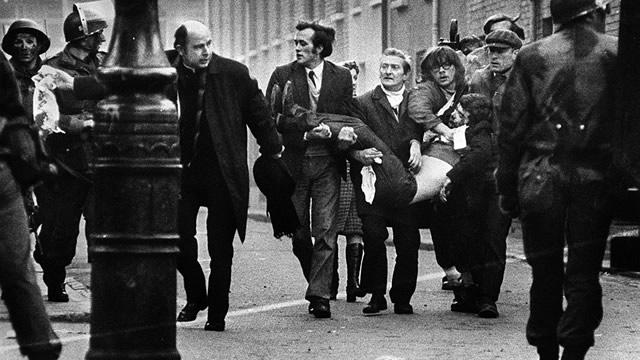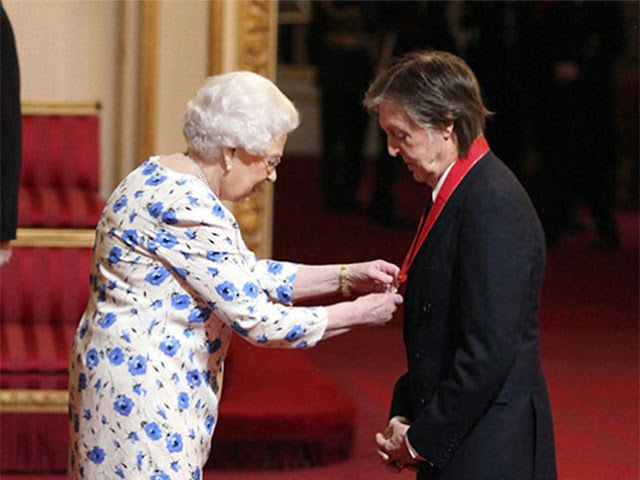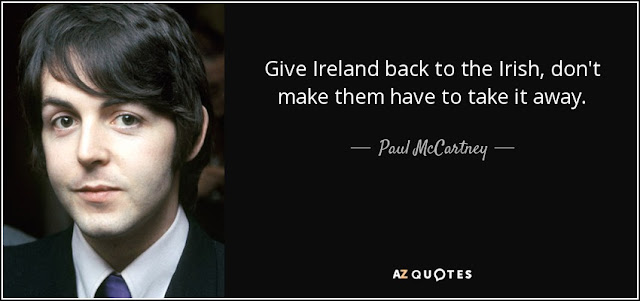Affable Paul McCartney was always the nice
Beatle, the one with the boyish smile and easy disposition. Not much
into politics or causes.
That was John’s thing. One of the most gifted and prolific song writers of
all time, he specialized in catchy melodies and memorable hooks. His lyrics were simple and straightforward. The deep
stuff, well, that was mostly John, too.
As he would put it in the song for his new band Wings, “Some
people wanna fill the world with silly love songs. And what’s wrong with that?”
But
on January 30, 1972 Paul got mad.
Really mad. Mad enough to write a
song.
That
morning he heard shocking news from Belfast, Northern Island. Members of a unit of elite paratroopers had opened fire
on unarmed and peaceful demonstration against detention
without trial. 13 were killed outright and dozens wounded.
Authorities had decided to allow the march within Catholic Derry but to prevent it from entering Guildhall Square. The First
Battalion of the Parachute Regiment (1 Para) was sent to the scene with specific orders to block the march at that point with force, if necessary.
Leaders
decided not to challenge the troops, diverting
the main march to Free Derry Corner,
where they were assured they would be safe from attack. A small number of local youths, however, broke
from the main march and
continued to Guildhall Square,
pelting an Army Barracks with stones and taunting troops. Water
cannon, tear gas, and rubber bullets were deployed, but two rioters were shot and wounded by live ammunition.
At 4
PM, responding to unfounded rumors
of an IRA sniper, the Paras were
ordered to enter the Bogside district where the peaceful marchers were still assembled. An order
was given to fire live rounds. 17 year
old Jackie Duddy was shot next to a Roman Catholic Priest as both fled from the troops. Orders
were given to continue to pursue
demonstrators at the edge of Free
Derry Square.
Troops
opened up with indiscriminate fire
and continued to
shoot even after receiving direct orders to stop. Twelve more, all unarmed, were killed while
fleeing or while attempting to aid those who had fallen. At least one was shot and killed while waving a white handkerchief
and going to the aid of a fallen boy.
Another was shot and injured then executed
by a close range shot to the head as he pleaded that he had lost
feeling in his legs. 14 others were
shot, one of whom, shot at some distance from the main action and not even involved, died months later. Two demonstrators were run over and seriously maimed by armored personnel carriers. No British soldier was wounded by
gunfire or reported any injuries.
Bloody Sunday, as it came to be
known changed everything. Any chance at peaceful change through non-violent protest was out the window. Radicalized youth flocked to the militant Provisional IRA (Provos)
who stepped up their own military campaign against the Army.
Of
course, that day McCartney didn’t know all
the details. But he did know that many young men, a lot of
them with shaggy dark hair, shod in Beatle boots, and wearing thin coats
styled after the now passé—in
Britain—Mod look that the Fab Four had
popularized, could have been him.
Like
so many Liverpudlians, McCartney was
of Irish descent. His mother was an Irish Catholic, his father a lapsed
Protestant. While baptized Catholic, he was sent to secular schools, not parochial
ones, and brought up in a household in which religion played a minor role. But he knew
that no matter how deep his family’s roots in England might be, he would always be a bog hopper to many.
After
watching BBC coverage of the event,
an angry, passionate McCartney set down and in less than two hours banged out the lyrics and picked out a tune on the piano. His wife, Linda, was by his side. He would share
writing credit for the song with her.
It was the same arrangement he had with his former writing partner, John
Lennon. And just as some Lennon and
McCartney songs were totally his own work, so was the song he called Give Ireland
Back to the Irish.
That
night he called his mates in his new
band Wings to meet him at Island
Studios in London’s Notting Hill
on February 1, in just two days. For
Irish guitarist Henry McCullough it
was his first recording session with
the band. With his usual meticulous attention to detail, McCartney arranged to have a crew on hand to film and document the band as it learned and rehearsed
the song. In a little more than two
hours, two tracks were laid down—vocal and an instrumental version of the song.
McCartney
was adamant about rushing the record to
release as a single. When word of his plans reached the ears of executives at his record label, all hell broke
loose. McCartney would later recall:
From our point of
view it was the first time people questioned what we were doing in Ireland. It
was so shocking. I wrote Give Ireland
Back to the Irish, we recorded it and I was promptly phoned by the Chairman of EMI [Wings’ record label], Sir
Joseph Lockwood, explaining that they wouldn’t release it. He thought it
was too inflammatory. I told him that I felt strongly about it and they had to
release it. He said, “Well it’ll be banned”, and of course it was. I knew Give Ireland Back to the Irish wasn’t an
easy route, but it just seemed to me to be the time. All of us in Wings felt
the same about it. But Henry McCullough’s brother who lived in Northern Ireland
was beaten up because of it. The thugs found out that Henry was in Wings.
Lockwood,
of course, could not afford to alienate his label’s biggest asset.
The records were pressed and shipped, complete with provocative
shamrocks adorning the yellow label. The single was released with the vocal
version on the A side and the instrumental on the B on February 25 in the United Kingdom and Ireland and three
days later in the US.
As
predicted it was banned. Every effort
was made to suppress any knowledge of
it. It was banned by the BBC, Radio Luxembourg,
and the Independent Television Authority. On the BBC Radio 1 hit
parade show Pick of the Pops,
Alan Freeman had to refer to it as “a
record by the group Wings.” McCartney and Wings were denounced in thundering newspaper editorials and in
the House of Commons. McCartney, the former darling of the press, was suddenly a pariah, at least among the Tory establishment and many “patriotic”
ordinary Britons.
McCartney
told friends, “I’ll never be a knight now.” He was eventually
knighted by Queen Elizabeth more
than two decades later in 1995 after many lesser pop musicians were elevated
ahead of him. Even then there was a minor furor among Tories at the honor.
Despite
the bans, folks in Britain could hear the song on broadcasts from the Irish Republic and the Continent. And, as always, the lure of the banned
drew thousands to record shops to snap up the discs. Despite the ban Give Ireland Back to the Irish climbed to # 16 on the UK Singles Chart, and # 21 in the US Billboard
Hot 100. Quite naturally it soared
to the top of the Irish charts and sat there for a while.
Did
McCartney’s uncharacteristic protest change anything? Who knows?
But in fact, public opinion in Britain slowly changed, even
though the bloody IRA bombing campaign
that followed which hardened many hearts against the Irish. When the facts about Bloody Sunday slowly emerged,
the consensus was that it was not only a tragedy, but an unmitigated
disaster. It took decades but
eventually the Accords guaranteeing
minority Catholic rights and the disarmament
of both the IRA and Protestant paramilitaries
resulted in a sometimes still uneasy
peace in a war weary nation. The Army was withdrawn.
Anyway,
here is what Paul McCartney wrote that day in his righteous anger.
Give Ireland Back to the Irish
Give Ireland
back to the Irish
Don’t make them have to take it away
Give Ireland back to the Irish
Make Ireland Irish today
Great Britain you are tremendous
And nobody knows like me
But really what are you doin’
In the land across the sea
Tell me how would you like it
If on your way to work
You were stopped by Irish soldiers
Would you lie down do nothing
Would you give in, or go berserk
Give Ireland back to the Irish
Don’t make them have to take it away
Give Ireland back to the Irish
Make Ireland Irish today
Great Britain and all the people
Say that all people must be free
Meanwhile back in Ireland
There’s a man who looks like me
And he dreams of god and country
And he’s feeling really bad
And he’s sitting in a prison
Should he lie down do nothing
Should give in or go mad
Give Ireland back to the Irish
Don’t make them have to take it away
Give Ireland back to the Irish
Make Ireland Irish today
Give Ireland back to the Irish
Don’t make them have to take it away
Give Ireland back to the Irish
Make Ireland Irish today.
—Paul McCartney






Excellent post Patrick!
ReplyDeleteVery informative post, Patrick. I am a bit confused. You said the news came to McCartney from Belfast. Bloody Sunday actually occurred in Londonderry, also known as Derry, about 75 miles northwest of Belfast.
ReplyDeleteWell done Professor Murfin!
ReplyDelete